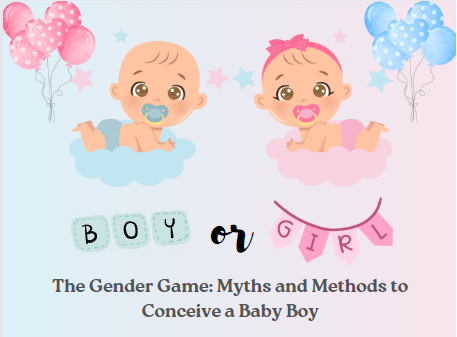The Gender Game: Myths and Methods to Conceive a Baby Boy

Introduction
The dream of predicting a baby’s gender before its conception has captured human imagination for centuries. From ancient rituals to modern scientific methods, the allure of influencing the odds has created a myriad of myths and methods. This guide aims to dissect the “Gender Game”, sifting through the numerous tales and techniques that have been handed down through generations or proposed by modern science. While the journey to conceiving a baby boy (or girl) can be filled with anticipation, it’s essential to approach these myths and methods with a blend of curiosity and skepticism.
Also Read:- Beyond Pink or Blue: Understanding the Science of Gender Conception
Myths Surrounding Conceiving a Baby Boy
- Dietary Influence: It’s commonly believed that consuming foods rich in potassium and sodium, like bananas and meat, can increase the chances of having a boy. However, no scientific evidence conclusively supports this.
- Sexual Positions: Some folklore suggests that deeper penetration during intercourse, such as the doggy style position, can favor the conception of a boy. The theory is that it helps faster but less resilient male sperm reach the egg more efficiently.
- Timing of Intercourse: An age-old belief posits that having intercourse on the day of ovulation or shortly after increases the odds of conceiving a boy. This is based on the idea that Y-chromosome (male) sperm swim faster and may reach the egg first.
- Lunar Theories: The Chinese Gender Prediction Calendar, based on the mother’s age and month of conception, has been used for generations to predict a baby’s gender. Similarly, some cultures believe conceiving during a specific moon phase can determine gender.
- Body pH Levels: An alkaline vaginal environment is believed to be more favorable for male sperm, leading to methods like douching or consuming alkaline foods. However, altering the body’s natural pH can be risky and isn’t medically advised.
Modern Methods to Increase Chances of Conceiving a Boy
- Sperm Sorting: The MicroSort technique separates X and Y chromosome sperm based on their DNA content. The chosen sperm type is then used for artificial insemination or IVF. While this method has a higher success rate than natural methods, it’s not foolproof.
- IVF with PGD (Preimplantation Genetic Diagnosis): Here, embryos are created outside the womb and screened for gender before implantation. It’s one of the most accurate methods available but is costly, ethically debated, and generally reserved for preventing gender-linked genetic diseases.
- Ovulation Timing: Using ovulation kits to precisely determine the ovulation day and timing intercourse closely can be a more calculated approach based on the myth of Y-sperm speed.
- Elective C-Section: Some believe that choosing the date of delivery, especially based on lunar calendars, can influence the baby’s gender. However, elective C-sections come with medical risks and should be approached cautiously.
Conclusion
The quest to influence a baby’s gender has been a part of human history for eons. While some methods have a basis in science, many are steeped in cultural and anecdotal beliefs. Couples venturing down this path should prioritize health, safety, and ethics over gender preference. After all, the joy of parenthood transcends beyond the binaries of pink or blue.









